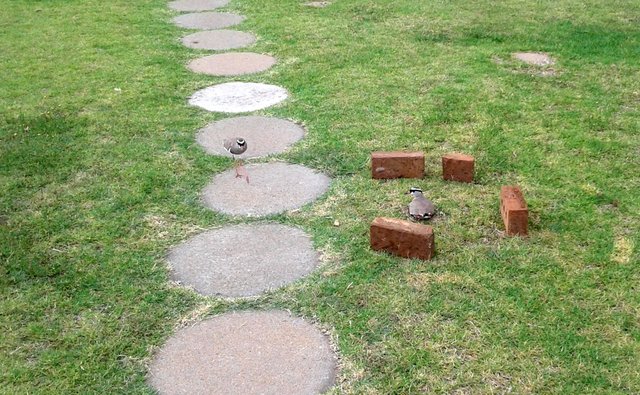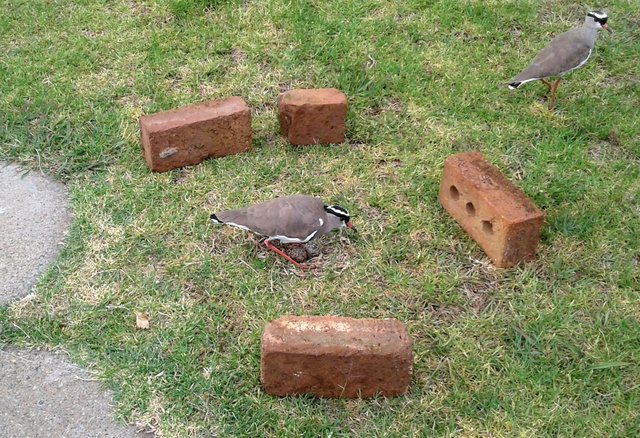
These Crowned Plovers made a nest right next to a pathway in the garden,
very close to where a pair of Dikkop have made their nest.

The male keeps guard, to make sure you do not approach to close to the nest.


Wikipedia Article
General
The Crowned Plover, is a bird of the lapwing subfamily that occurs contiguously from the Red Sea coast of Somalia to southern and southwestern Africa. It is an adaptable and numerous species, with bold and noisy habits. It is related to the more localized Black-winged and Senegal Lapwings, with which it shares some plumage characteristics.
Description
The Crowned Plover is easily recognized by its combination of brown and white colours, with most tellingly, a black crown intersected by an annular white halo. Adults are noisy and conspicuous. Males measure on average 3% larger than females. Juveniles are dull versions of adults, vermiculated on the wings and mantle, the legs yellowy rather than red and the bill lacking the red base.
Habitat and numbers
Crowned Plovers prefer short dry grassland which may be overgrazed or burnt, but avoid mountains. In higher-rainfall areas such as parts of Zambia and Zimbabwe, they occur mainly as dry-season visitors. In dry regions of northern Botswana however, they are attracted in large numbers when good rainfall occurs. In southern Africa their highest concentrations are to be found in the dry central Kalahari region. Although generally outnumbered by Blacksmith Lapwings, they are the most widespread and locally the most numerous lapwing species in their area of distribution. Their numbers have increased in the latter part of the 20th-century after benefiting from a range of human activities. They live up to 20 years. The Crowned Lapwing is one of the species to which the Agreement on the Conservation of African-Eurasian Migratory Waterbirds (AEWA) applies.
Behaviour
Crowned Plovers and the more localized Black-winged Plovers sometimes associate and do not show mutual aggression, even within breeding territories. Different Crowned Plovers males do however posture aggressively when nesting territories are established. The loser in an encounter assumes a special posture to signal his defeat. Bare-part colours of males brighten in the breeding season. Different types of display flights lure the female to the defended territory. A female accepting the male and territory will follow the male during his display flight. Mates may be retained for life. Egg-laying is timed to precede the rainy season and most incubating is done by the female. The male assists only on hot days, when he either incubates or shades the nest.
All photos are my own property.
BIRD INFO SOURCE>>>> https://www.birdingbuddies.com
so cute animals I love it I up vote your post please check my blog
https://steemit.com/@juliana552
Downvoting a post can decrease pending rewards and make it less visible. Common reasons:
Submit
With pleasure
Downvoting a post can decrease pending rewards and make it less visible. Common reasons:
Submit
Hi! I am a robot. I just upvoted you! I found similar content that readers might be interested in:
https://en.wikipedia.org/wiki/Crowned_lapwing
Downvoting a post can decrease pending rewards and make it less visible. Common reasons:
Submit
My source is shown as https://www.birdingbuddies.com
Thank you for your vote
Downvoting a post can decrease pending rewards and make it less visible. Common reasons:
Submit
Plovers are very aggressive when you get too close to their nests! The also try and lead you away from the nest.
Downvoting a post can decrease pending rewards and make it less visible. Common reasons:
Submit
Yes very aggressive, the male actually charges you.
Downvoting a post can decrease pending rewards and make it less visible. Common reasons:
Submit